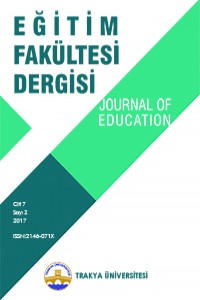Öğrencilerin Fen Bilimleri Dersindeki Hedef Yönelimlerinin Sınıf Ortamı Hedef Algıları ile Yordanması
Öz
Bu
çalışmada, ortaokul öğrencilerinin fen
bilimleri dersindeki sınıf ortamı hedef algıları (motive edici etkinlikler,
özerkliğin desteklenmesi, öğrenmeye yönelik değerlendirmeler) ile öğrencilerin öğrenme
yaklaşma ve performans yaklaşma hedef yönelimleri arasındaki ilişki
araştırılmıştır. Çalışmanın örneklemini, 316 ortaokul öğrenci oluşturmaktadır. Çalışmada
ele alınan değişkenler arasındaki önerilen ilişkileri içeren model, LISREL 8.8 programı kullanılarak yol
(path) analizi ile test edilmiştir. Elde edilen sonuçlara göre; motive edici etkinlikler ve özerkliğin desteklenmesi,
öğrencilerin öğrenme yaklaşma hedef yönelimini pozitif yönde tahmin ederken,
öğrenmeye yönelik değerlendirmeler ise öğrencilerin performans yaklaşma hedef
yönelimini pozitif yönde tahmin etmektedir.
Anahtar Kelimeler
sınıf ortamı hedef algıları yaklaşma hedef yönelimleri fen bilimleri
Kaynakça
- Ames, C. & Archer, J. (1988). Achievement goals in the classroom: Students' learning strategies and motivation processes. Journal of Educational Psychology, 80(3), 260.
- Ames, C. (1992). Classrooms: Goals, structures, and student motivation. Journal of Educational Psychology, 84(3), 261.
- Arkün, S., ve Aşkar, P. (2010). Yapılandırmacı öğrenme ortamlarını değerlendirme ölçeğinin geliştirilmesi. Hacettepe Üniversitesi Eğitim Fakültesi Dergisi, 39(39), 1-12.
- Church, M. A., Elliot, A. J. & Gable, S. L. (2001). Perceptions of classroom environment, achievement goals, and achievement outcomes. Journal of Educational Psychology, 93, 43-54.
- Dweck, C. S. & Leggett, E. L. (1988). A social-cognitive approach to motivation and personality. Psychological Review, 95(2), 256.
- Eccles, J. S., Wigfield, A., Midgley, C., Reuman, D., Iver, D. M. & Feldlaufer, H. (1993). Negative effects of traditional middle schools on students' motivation. The Elementary School Journal, 93(5)553-574.
- Epstein, J. (1989). Family structures and student motivation: A development perspective. In C. Ames & R. Ames (Eds.), Research on motivation in education (Vol. 3, pp. 259-295). San Diego, CA: Academic Press.
- Fosnot, C. T. (1996). Constructivism: Theory, perspectives, and practice. New York: Teachers College Press.
- Fraenkel, J. R. ,Wallen, N. E. & Hyun, H.H. (2012). How to design and evaluate research in education. (8th Ed.). New York: McGraw-Hill.
- Gherasim, L. R., Butnaru, S., & Mairean, C. (2013). Classroom environment, achievement goals and maths performance:Gender differences. Educational Studies, 39(1), 1-12.
- Greene, B. A., Miller, R. B., Crowson, H. M., Duke, B. L. & Akey, K. L. (2004). Predicting high school students' cognitive engagement and achievement: Contributions of classroom perceptions and motivation. Contemporary Educational Psychology, 29(4), 462-482.
- Hıdıroğlu, F. M. (2014). The role of perceivedclassroom goal structures, self-efficacy, and the student engagement in seventh grade students' science achievement. Middle East Technical University, Türkiye: Yayınlanmamış yüksek lisans tezi.
- Jöreskog, K. G. & Sörbom, D. (2007), LISREL 8.80. Scientific Software International.
- Kaplan, A. & Midgley, C. (1999). The relationship between perceptions of the classroom goal structure and early adolescents' affect in school: The mediating role of coping strategies. Learning and Individual Differences, 11(2), 187-212.
- Koul, R., Roy, L. & Lerdpornkulrat, T. (2012). Motivational goal orientation, perceptions of biology and physics classroom learning environments, and gender. Learning Environments Research, 15(2), 217-229.
- Lau, S. & Nie, Y. (2008). Interplay between personal goals and classroom goal structures in predicting student outcomes: A multilevel analysis of person-context interactions. Journal of Educational Psychology, 100(1), 15-29.
- Linnenbrink, E. A. (2004). Person and context: Theoretical concerns in achievement goal theory. In: M. L. Maehr & P. R. Pintrich (Eds), Advances in Motivation and Achievement (Vol. 13, pp. 159-184). Greenwich, CTI: JAI Press.
- Meece, J. L., Anderman, E. M. & Anderman, L. H. (2006). Classroom goal structure, student motivation, and academic achievement. Annu. Rev. Psychol, 57, 487-503.
- McMillan, J.H. & Schumacher, S. (2006). Research in education: Evidence-based inquiry. (6th Ed.). London: Pearson.
- Midgley, C., Kaplan, A. & Middleton, M. (2001). Performance-approach goals: Good for what, for whom, under what circumstances, and at what cost?. Journal of Educational Psychology, 93(1), 77-86.
- Milli Eğitim Bakanlığı, (2013). İlköğretim kurumları (ilkokullar ve ortaokullar) fen bilimleri dersi (3, 4, 5, 6, 7 ve 8. sınıflar) öğretim programı. Ankara.
- Pintrich, P. R. (2000). An achievement goal theory perspective on issues in motivation terminology, theory, and research. Contemporary Educational Psychology, 25(1), 92-104.
- Pintrich, P. R. & Schunk, D. H. (2002). Motivation in education: Theory, research, and applications (2nd Ed.). Englewood Cliffs, NJ: Prentice Hall Merrill.
- Şenler, B. ve Sungur, S. (2007). Hedef yönelimi anketinin Türkçeye çevrilmesi ve adaptasyonu, 1. Ulusal İlköğretim Kongresi, Ankara.
- Sungur, S. (2007). Modeling the relationships among students' motivational beliefs, metacognitive strategy use, and effort regulation. Scandinavian Journal of Educational Research, 51(3), 315-326.
- Sungur, S. ve Güngören, S. (2009). The role of classroom environment perceptions in self-regulated learning and science achievement. Elementary Education Online, 8(3), 883-900.
- Şaşan, H. H. (2002). Yapılandırmacı Öğrenme, Yaşadıkça Eğitim, 74, 49-52.
- Tapola, A., & Niemivirta, M. (2008). The role of achievement goal orientations in students' perceptions of and preferences for classroom environment. British Journal of Educational Psychology, 78(2), 291-312.
- Yerdelen-Damar, S. Y., ve Aydın, S. (2015). Fen öğrenme yaklaşımlarının öğrenme ortamı algıları ve hedef yönelimleri ile ilişkisi. Eğitim ve Bilim, 40(179), 269-293.
- Yeşilyurt, E. (2011). Yapılandırmacı öğrenme temelli bir öğretim programının oluşturulmasına ilişkin öğretmen adaylarının görüşlerinin değerlendirilmesi.Turkish Studies, 6(4), 865-885.
- Wolf, S. J. & Fraser, B. J. (2008). Learning environment, attitudes and achievement among middle-school science students using inquiry-based laboratory activities. Research in Science Education, 38(3), 321-341.
Ayrıntılar
| Bölüm | Makaleler |
|---|---|
| Yazarlar | |
| Yayımlanma Tarihi | 20 Haziran 2017 |
| Yayımlandığı Sayı | Yıl 2017 Cilt: 7 Sayı: 2 |



